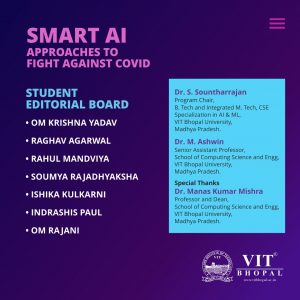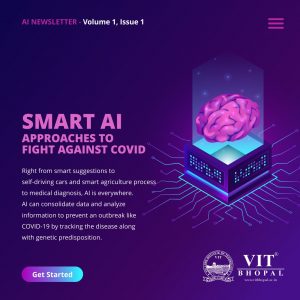SMART AI APPROACHES TO FIGHT AGAINST COVID
SMART AI APPROACHES TO FIGHT AGAINST COVID
INTRODUCTION
Artificial Intelligence (AI) is the induction of human intelligence in software entities, may it be an agent, a program, or a machine.
The concept is to create a neural network like the one in our brain for the processing of a program that can use prerequisite knowledge and perform all cognitive tasks as we do.
Right from smart suggestions to self-driving cars and smart agriculture process to medical diagnosis, AI is everywhere. AI can consolidate data and analyze information to prevent an outbreak like COVID-19 by tracking the disease along with genetic predisposition. Time is very valuable factor in controlling this pandemic, and AI has made it easier right from tracking the pandemic to restraining from using fever detectors. It can help to reduce the chances of exposure, healthcare professionals to the disease.
Other than prevention, AI has contributed to screening and identifying high-risk patients, resource management in hospitals, and promoting the process of finding a cure. In the retail sector, it can predict the usage of products, shortages, and help in warehouse automation and building up contact less delivery options.
This newsletter presents the smart applications of AI and AI approaches that have assisted us against the pandemic COVID 19. The AI applications areas covered in this presentation are
- Medicine and Healthcare
- Social Network
- Bio Research
- Education
- Computer Vision
- Drones
- Chatbots
We also present here how AI has and will wisely continue to extend itself for people during this COVID-19 outbreak.
MEDICINES AND HEALTH CARE
AI has an important role to play in fighting against this global pandemic. With the proper quality and quantity of data support from the governments across the globe, AI can provide accurate and reliable smart solution to the worldwide problems.
Here is an example to show how machines AI helped in predicting outbreak of an infectious disease. Last December, an AI-based company, using its machine learning model, monitored outbreaks of infectious disease around the globe. They alerted various governments and hospitals for an unusual peak in the pneumonia cases in the center of epidemic in China – Wuhan. Within a short span of time, nine days from this incident, WHO officially declared the pandemic disease caused by novel coronavirus SARS-CoV-2 known as COVID-19, today.
The benefit from AI to healthcare area can be broadly classified under: prediction of the epidemic, diagnosis of the disease, and treating the patients.
1.PREDICTION:
Companies like BlueDot and Metabiota use a Natural Language Processing algorithm to predict the new hotspots through the health care reports and inform the health officials and government. The predictive algorithms use the aviation data available for anticipating the risk of some hubs that may face due to either arrival or departure of infected patients.
In another way, unsupervised ML enables AI to identify its own patterns in the data, rather than being explicitly modified. “When you do prediction, you’re looking for new behavior”, says Stratify CEO, Derek Wang
![Figure 1. AI Prediction [2] VIT Bhopal - Best University in Central India - ainews1-300x221 VIT Bhopal - Best University in Central India - ainews1-300x221](https://vitbhopal.ac.in/wp-content/uploads/2020/05/ainews1-300x221.jpg)
Figure 1. AI Prediction [2]
The Fig. 1 shows AI prediction tool to predict patient worse condition, Acute Respiratory Distress Syndrome (ARDS), which is building-up of fluid in the lungs. Many researchers worked to develop an AI tool which can predict such patients who need more medical care and attention. But the researchers were amazed to study the most significant characteristics such as lung scan patterns, fever and cough that do not help in predicting that whether this patient will develop ARDS or not.
Research continued and a new AI tool discovered that the tendency to develop ARDS in a patient can be predicted by three features, that are- haemoglobin levels, liver enzyme alanine aminotransferase (ALT) levels, and myalgia (muscle pain). This tool predicted ARDS in patients with an accuracy of 80 percent. By taking help of this tool, doctors and medical staff can give more attention and needed medication to the patients who are more likely to develop ARDS and go towards the fatal stage [1].
2.DIAGNOSIS:
Reverse Transcription-Polymerase Chain Reaction (RT-PCR) test is used for testing COVID-19 suspects. But, the shortage of RT-PCR test kits and proper testing centres is the problem faced by severely hit countries in the early stage of pandemic across the globe. Although RT-PCR is the gold standard for the diagnosis of this disease, the lab test sometimes gives false negative reports due to human intervention in preparation of sample and experimental quality.
The containment of virus is also compromised when health warriors take mouth swab of the suspected patients manually as shown in fig.2. There is high risk of them getting infected by the virus. This risk can be minimized by taking help of robots for sampling, testing and treating patients and by using AI enabled techniques for diagnosing [3].
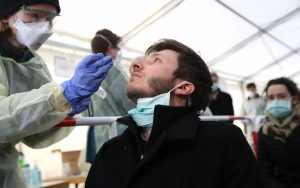
Figure 2. A health worker taking swab from a suspected patient
The wheeled robots are controlled by remotes and can be used for taking nose/ throat swabs. Robotic arm can perform ultrasounds, as well as it can hear the sounds made by patient’s organs which is normally done by a doctor using stethoscope, that involves physical contact between the patient and the doctor. Using wheeled robots, the patients can be easily monitored by the doctors [ 4] , while being in proper isolation as shown in fig.3.
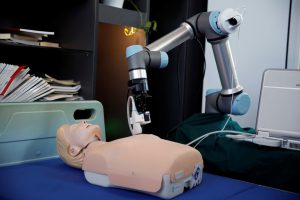
Figure 3. A robotic arm, taking CT-scan of a dummy patient
Smart Artificial Intelligence Techniques to read CT-scans and X-ray scans, more efficiently, can also be used in diagnosing COVID-19. Unlike the proper testing labs required for RT-PCR tests, X-ray and CT-scan machines are easily resourced. But, in the conventional process, there is again the same problem that the containment of virus is compromised and doctors are at high risk while taking these scans.
In the conventional workflow, first a technician has to guide the patient by positioning him/her over the bed according to the required protocol. Then, they have to identify the target body part visually and they have to adjust the x-ray tube to be correctly over the patient’s target body part. In all this procedure, there is high risk of the technicians getting infected. All these risks can be avoided by automating the workflow by using technology with artificial intelligence. During this pandemic many contactless workflows for diagnosing are established
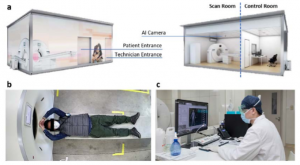
Figure 4. An automated CT-scan workflow
An automated CT scan workflow consists of remote-controlled CT platforms which are embedded with cameras and microphones, as shown in fig. 4(a). There are two rooms, one is the scan room and other one is the control room which is completely isolated. As the patient goes inside the scan room, he/she is instructed by the doctor, using visual and audio devices, to pose on the bed fig. 4(b). The doctors can correct the patient’s pose by judging it through AI enabled cameras which are placed over the patient’s head as shown in fig. 4(c). After the images are ready, they are further processed and then used for diagnosing the disease [5].
Also, an Israeli company has modelled techniques which take voice samples as input and classify the patient whose voice is taken to be positive or negative [6]. This could be of great help, as it provides complete isolation to both the doctors and patients. All one needs is to record his/her voice and send it as a message to the medical team via a smartphone.
3.TREATMENT:
With essential data, AI is helping in the development of the vaccine to fight against the evil pandemic that the entire world is fighting against.
SRI International is adapting AI by using deep learning in finding optimal covid-19 drug candidates that the researchers can use towards the discovery of cure. AI is not only helping in finding vaccines, but also in finding treatment for COVID-19.
“AI powered pharmacology platform” – developed by AI VIVO (Cambridge, UK) has been successful in identifying the list of drugs that would be most optimal in treating COVID-19 patients. A data of 90,000 possible drug candidates was prepared in 15 days AI VIVO’s optimised prediction engine that has predicted a list of about 30 drug candidates, which could be used for treating patients.
On the top of the list, predicted by the AI engine, is the drug which every country is seeking for, that is- Chloroquine (anti-malarial drug). Yes, this is the drug which is abundantly present in India, which every country is requesting for, even the world power- USA. And this prediction was pre-made using this AI-engine [7].
Computer (AI) is used to map out the infected cells. Coronavirus enter into human cells through “spike proteins,” but they take on different shapes as they are undergoing mutation continuously. This is the major reason for the delay of COVID-19 vaccines development.
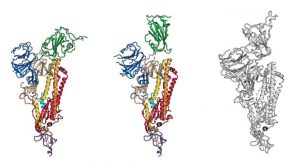
Figure 5. Structure of a human cell
But, understanding the structure of the virus SARS-Cov-2 is utmost important for the development of cure for COVID-19, Many research papers reported the structure of spike proteins in this virus. Scientists can explore these data to understand the virus structure.The three different structures of spike proteins are shown fig-5., and these spike proteins have an important role in viral entry into the human cells. The left structure is a molecular key-RBD in down orientation, the middle one is an RBD- up conformation, and the right one shows the SARS virus for comparison [8].
In conclusion, AI can be used to tackle this pandemic situation efficiently by predicting, diagnosing and treating the patients. Up to April 26, 2020, 28,10,325 confirmed cases worldwide and 1,93,825 deaths across the globe [9], COVID-19 is almost keeping the world in lockdown. AI alone can do nothing to tackle this evil but if humans use AI efficiently and properly along with the help of governments across the world, technology can be a saviour. Also, this could be possible only if good quality and quantity of data is made available to the researchers and data scientists across the globe. AI needs big data, but right now the available data is small.
SOCIAL NETWORK
Tech platforms have been remarkably proactive concerning transparency. During the past few weeks, several public announcements made concerning the steps taken in relevance to the pandemic.[11]
- The uncertainty of the pandemic has inevitably resulted in the propagation of myths on social media platforms.[10]
- Technology giants like Google and Facebook are perceptively battling to combat the waves of conspiracy theories, phishing, information, and malware.[10]
- YouTube, on the alternative hand, directly links users to the WHO and similar credible organizations for info.[10]
- Videos that misinform are worn for and brought down as shortly as they are uploaded.[10]
- All of the digital platforms have established dedicated websites, hashtags, and handles to talk their response and actions in relation to the COVID-19 crisis and each one among the platforms have approached to partnerships with WHO, agency or alternative health organizations as sources of current and correct content.[11]
- One among the foremost notable parts inside the platforms’ response up to now is that the larger use of smart AI and machine learning systems for content moderation, because of the requirement to allow social distancing for his or her staff and contractors.[11]
- The Coronavirus information pursuit centre hosted by NewsGuard has found 141 sites — eighty-two of that NewsGuard had known as unreliable before the coronavirus reported — that are publication false claims concerning the coronavirus. [12]
- NewsGuard provides credit ratings and elaborated “Nutrition Labels” for thousands of reports and data websites. Fig. 6 shows
- the social media apps.[12]

Figure 6. Logo’s of Social Media Apps
BIO RESEARCH
The Covid-19 pandemic illustrates how AI can do a wonder in the race to seek out an antidote [13]. The application of AI is shown in fig 7 & 8. and how AI has approached the field of Bio research :
- Smartly elements of an immunogen by understanding infectious agent’s-super-molecular structures.
- To search and analyse tens of thousands of relevant medical research papers at a rapid pace.
Vaccines imitate an infection and antigenic- , inflicting the body to provide defensive white-blood cells. There are three main types of vaccines: whole-cell vaccines, which use killed or weakened pathogens; subunit vaccines, which use a part or product of the germ; and macro-molecule vaccines inject macromolecules of the infectious agent into human [14].
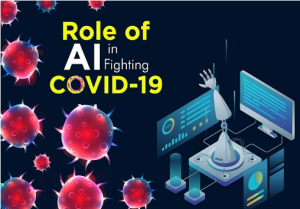
Figure 7. AI vs Covid – 19 [17]
AI is beneficial in accelerating the development of sub unit and macro-molecule vaccines. An important part of viruses, proteins and Nucleic acids are made up of a sequence of amino acids and nucleotides respectively [15]. Once the form is known, scientists will be able to develop a drug that breaks this chain of amino acids or block the replication of the nucleic acids so that the growth of the virus is arrested in human body. Researchers for the very first time used a popular biology technique to create the first 3D atomic scale map of the part of the virus that attaches and infects the human cells. The team responsible for this critical outbreak had spent a lot of years for research of other coronaviruses. Many predictions were made by AlphaFold. One of them provided a
prediction about this spike protein’s structure. Some are currently building on this work by making new proteins that neutralize the virus. In theory, these proteins keep on with the spike protein preventing infectious agent particles from infecting healthy cells [16].
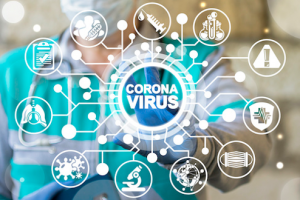
Figure 8. Applications of AI in healthcare [18]
Kaggle (Google’s machine-learning and data science platform) is hosting the covid-19 research challenge that looks forward to produce a wide range of insights regarding the pandemic. The research challenge (released on the 16th of March 2020) has already garnered over 500,000 views and is being downloaded more than 18,000 times.
EDUCATION AND AI
INTRODUCTION
Plato quoted, “The direction in which education starts a man will determine his future in life”.To maintain social distancing and abide by the government rules, online learning and distance learning platforms are being promoted. Fig.9 shows the clever application of AI in education.
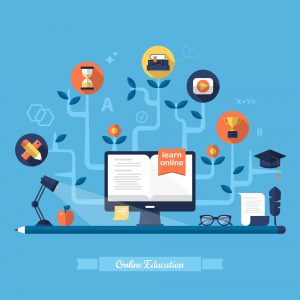
Figure 9. Applications of AI in Education [19]
HOW HAS AI APPROACHED IN THIS FIELD?
It is tedious work to monitor progress reports and assignments of students. But, AI rationally minimizes the task by assigning algorithms which track progress and personalize students learning.
- The algorithm works on various aspects like how much time does a student spends on a topic or how many questions are answered correctly. How is the world handling education during this pandemic?
CHINA:
- Ding Talk

Figure 10. Ding Talk app [20]
Alibaba Group developed the Ding Talk app as shown in fig. 10. The working condition of this App is shown in fig.11 This App uses AI to translate live interactive sessions for students in 11 different languages. It comes with features like online assignments, gradings and marks as well

Figure 11. Working of the Ding Talk app [21]
INDONESIA:
WeKiddo
Fig 12 shows Wekiddo developers have developed AI powered app to track children’s academics and to connect the parents, teachers and the students. Currently, this e app is working in 47 schools in that area.

Figure 12. The WeKiddo Developers [22]
OTHERS:
Google classroom
Fig. 13 shows Google Classroom. It is the most commonly used platform, with an interactive interface. This platform allows the teachers to post bulk notes, share links and post graded assignments. Students can also raise doubts anonymously

Figure 13. Google Classroom [23]
Coursera
Fig. 14 shows Coursera which provides both free and paid certification courses from various universities worldwide and tech giants like Google and IBM

Figure 14. Coursera [24]
COMPUTER VISION
Computer vision (CV) is an artificial intelligence technology which is used to analyze visual data, and to find the best solution based upon perfect decision and without missing any factors. Computer vision is used to detect corona virus infection, checking the temperature of the individuals at airports using thermometer guns. The applications of computer vision are temperature checks, CT scans and Mask check.
APPROACH OF COMPUTER VISION IN DEALING WITH THE VIRUS:
THERMOMETER GUNS:
Thermometer Guns as shown in fig. 15 have been designed that can perform temperature checks on a larger scale. Cameras with built-in infrared sensors, connected to the CV system, can predict temperatures of two hundred people per minute, with the accuracy within a range of 0.5 degrees Celsius. The AI-driven software automatically marks anyone with a temperature above 37.3 degrees.
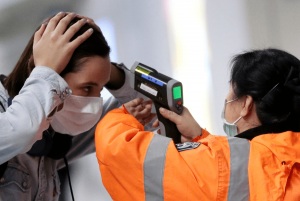
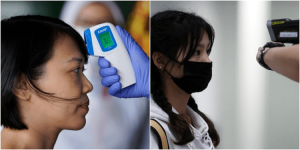
Figure 15. Use of Thermometer guns [25]
CT SCANS:
One of the most recent innovations that can diagnose COVID-19 patient’s by chest CT scans within 20 seconds as shown in fig 16. The accuracy turned out to be 95%. Medical centers can now gain precious time as this process used to take at least 15 minutes for healthcare professionals.
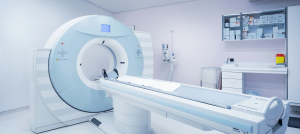
Figure 16. CT Scan [26]
CORONAVIRUS PATIENT:

Figure 17. COVID-19 Patient image [27]
HEALTHY PERSON:

Figure 18. Healthy patient image [28]
Apart from identifying people who are sick, computer vision helped in many ways.
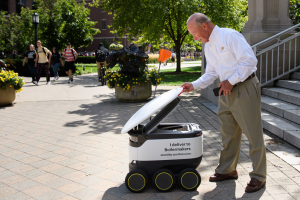
Figure 19. Robots [29]
Vision Guided Robots, as shown in fig.19, have been a huge help. These robots consist of 3-D cameras and image recognition software with the help of which robots can deliver food, clean and sanitize buildings, and even navigate patients through different departments.
AAROGYA SETU APP:
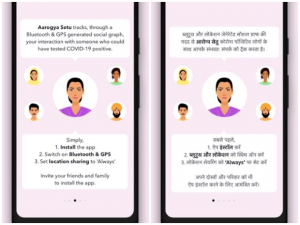
Figure 20. Demonstration of Aarogya Setu App [30]
The Government of India has developed an App namely Aarogya Setu app, as shown in fig. 20. This App, helps citizens remain safe by tracking their location and using Bluetooth to ensure that they remain away from corona patients and hotspots, maintaining secrecyThe Government of India has developed an App namely Aarogya Setu app, as shown in fig. 20. This App, helps citizens remain safe by tracking their location and using Bluetooth to ensure that they remain away from corona patients and hotspots, maintaining secrecy
DRONES IN CONTROLLING VIRUS
AERIAL SPRAY AND DISINFECTION:
- Fig .21, Drones are being customized for spraying disinfectants in some public places and on epidemic prevention vehicles traveling between compacted areas. (Coronavirus spreads via touching contaminated surfaces. Spraying disinfectants helps in reducing transmission.)
- Depending on the application, the drone can be more efficient than manually spraying.[31]
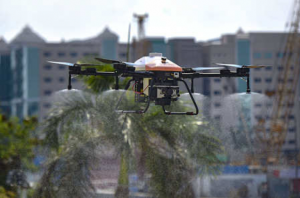
Figure 21. Drones for disinfection [32]
TRANSPORT OF SAMPLES AND MEDICINES:
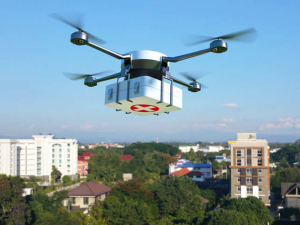
Figure 22. Drones for Delivery [33]
The drones will greatly help in transporting and delivering medical sample efficiently and without human contact throughout the transport cycle of samples as shown in fig 22.
It can also increase the speed of delivery of test materials and medicine for crucial tests required for patients and doctors. [31].
CONSUMER DRONE DELIVERY:
Drones delivers daily needed items to make sure that people have access to food and avoid human contact as shown in fig. 23.
This keeps citizens safe at home and helps them to get access to any or all necessary goods.[31]
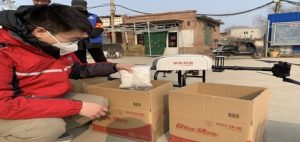
Figure 23. Demonstration of item delivery via drones [31]
DRONE SURVEILLANCE:
Policemen aren’t enough to perform drill everywhere in cities.In slums and densely populated areas, policemen can’t keep watch on everyone.Drone surveillance as shown in fig.24 will help in keeping a watch on every activity in various areas of a city and to take action against those who don’t follow lockdown.It helps in crowd control too.[33]
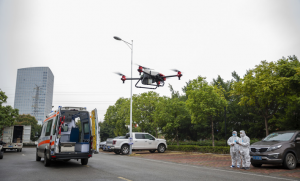
Figure 24. Crowd Controlling Drones [31]
CHATBOTS
Conversations bots are Artificial Intelligence chatbots specifically designed to interact with the users seeking information which is frequently asked.
It spares hours of human labour as commonly asked questions or queries can be answered by these chatbots efficiently and at the same time one can brainstorm on the other tasks at hand.
The governments around the world are opting the use of conversational AI as it is tedious for them to interact with every citizen, also it is pretty difficult for people to actually come to call centers due to the lockdowns and it would not only be a threat for them, but also for the people around them. This initiative is taken by Facebook, WhatsApp, Telegram, Twitter and many other tech giants collaborating with the governments and the UN.
Another advantage is that the bots provide real-time information and they are available at all times. The bots learn wisely from their previous experiences, thus they tend to get better with each conversation.
The Indian government has come up with My Corona hub: https://m.me/MyGovIndia for this purpose.
MYGOV CORONA HELPDESK

Figure 25. Interface of Helpdesk [34]
Fig.25 shows how the MyGov Corona Helpdesk works –
The Indian government launched a WhatsApp chatbot called the–MyGov Corona Helpdesk–to help users with verified information on the chat app that has gained notoriety for the circulation of unverified information in the country.Telecom companies have joined the bandwagon too. Last week, Reliance Jio launched a chatbot — a symptoms tracker– which assesses the possibility of an individual coming down with the virus.
APOLLO247:
Following Jio’s footsteps, Bharti Airtel partnered with Apollo hospitals to launch Apollo247.com, also available on the Airtel app. Once a user answers some simple questions regarding travel history and her/his health, the chatbots predict whether a user is at high or low risk, and whether she/he should take the COVID-19 test. That there are these many numbers of apps now available online, and the number of chatbots available to answers queries, is telling.
Fig.26 shows how the Apollo247.com works –
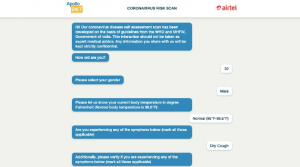
Figure 26. Working of Apollo247 [35]
On March 27, Goa became one of the first states to launch a self-assessment COVID-19 app. The state government has partnered with a health tech company Innovaccer. Inc that is based in San Francisco. It is similar to other apps in that a user can self-assess her or his level of risk. What’s important and helps in changing the outcomes, says Kanav Hasija, co-founder of the company, is keeping it simple, scalable, and useful with information on which people can take action and take it fast.
MICROSOFT CHATBOT CLARA:
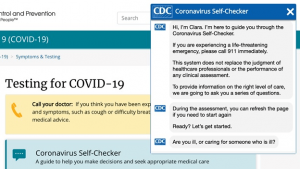
Figure 27. Microsoft’s chatbot Clara [36]
The CDC – US Centres for Disease Control and Prevention partnered with Microsoft to give birth to Clara, which uses AI to clear queries. Though, it cannot be used for diagnostics or treatments shown in fig. 27.
CONCLUSION
When coronavirus first stirred in Wuhan, companies like Alibaba, Baidu came forth to create enhanced healthcare facilities. As a matter of fact, Alibaba also claimed that their diagnose system is 96% accuracy.
In this COVID-19 pandemic, technology especially AI has played a major role. From identifying the severity of the disease in individuals and to helping researchers to identify the possible vaccines for this virus.
Since it is a tedious work to monitor progress reports and assignments per individual, thus AI minimizes the task by assigning algorithms which track progress and personalize students learning. WHO has also increased the involvement of computing (AI) in fighting this COVID-19. Machine Learning algorithms work easier for identifying similar protein structures, so that they can add the chain breaking protein in this to stop the growth of the virus in human body.
REFERENCES:
- https://economictimes.indiatimes.com/magazines/panache/this-artificial-intelligence-tool-can-predict-which-covid-19-patient-is-likely-to-develop-respiratory-disease/articleshow/74910757.cms, accessed on 12/04/2020.
- https://www.vectorstock.com/royalty-free-vector/magnifying-glass-with-artificial-intelligence-vector-23292143, accessed on 14/04/2020.
- https://www.telegraph.co.uk/global-health/science-and-disease/engineers-develop-robots-treat-test-covid-19-patients-bid-protect/, accessed on 12/04/2020
- https://www.abacusnews.com/tech/chinas-tsinghua-university-has-robot-arm-could-help-coronavirus-epidemic/article/3073977, accessed on 13/04/2020
- Shi et al., “Review of Artificial Intelligence Techniques in Imaging Data Acquisition, Segmentation and Diagnosis for COVID-19,” in IEEE Reviews in Biomedical Engineering, doi: 10.1109/RBME.2020.2987975
- https://www.forbes.com/sites/startupnationcentral/2020/04/13/israeli-startups-artificial-intelligence-covid19-coronavirus/#6352c8a84567, accessed on 14/04/2020.
- https://www.hospimedica.com/covid-19/articles/294781781/ai-platform-identifiestop-candidate-drugs-for-treatment-of-covid-19.html, accessed on 14/04/2020.
- https://www.geekwire.com/2020/ai-helping-scientists-fight-covid-19-robots-predicting-future/, accessed on 14/04/2020.
- https://www.bing.com/covid/local/india, accessed on 26/04/2020.
- https://www.entrepreneur.com/article/348368, accessed on 12/04/2020
- https://www.lawfareblog.com/covid-19-and-social-media-content-moderation, accessed on 12/04/2020
- https://www.publicknowledge.org/tracking-report-covid19-misinformation/ accessed on 12/04/2020
- https://www.google.com/url?sa=i&url=https%3A%2F%2Ftheceo.life%2F4-keys-to-strengthen-your-presence-on-social-media%2F&psig=AOvVaw0t7IOdeSMq_NiYqePEFxzV&ust=1586793911874000&source=images&cd=vfe&ved=0CAIQjRxqFwoTCJC1-o2i4-gCFQAAAAAdAAAAABAI, accessed on 12/04/2020
- https://www.fiercebiotech.com/research/covid-19-bio-researchers-race-to-repurpose-everything-from-antiviral-to-anticancer accessed on 12/04/2020
- https://indiabioscience.org/grants/covid-19-research-consortium accessed on 12/04/2020
- https://www.fiercebiotech.com/research/new-insight-into-why-malaria-drugs-work-against-some-cancers-could-boost-drug-development accessed on 12/04/2020
- https://hackernoon.com/covid-19-how-ai-is-helping-in-the-fight-x55l3y7z, accessed on 14/04/2020
- https://elevenews.com/2020/04/17/five-ways-blockchain-tech-can-help-us-during-this-pandemic/, accessed on 14/04/2020
- https://depositphotos.com/vector-images/online.html, accessed on 14/04/2020
- http://www.dv.co.th/blog-en/Alibaba-E-Commerce/, accessed on 14/04/2020
- https://medium.com/@judyzhu_83311/team-communication-in-china-ding-talk-by-taobao-a930bd475501, accessed on 14/04/2020
- https://jakartaglobe.id/tech/rise-of-elearning-apps-amid-covid19-pandemic accessed on 12/04/2020
- https://ravenswoodms.weebly.com/google-classroom.html, accessed on 14/04/2020
- https://www.myfreeproductsamples.com/free-makeup-samples/free-coursera-online-learning-courses/attachment/free-coursera-online-learning-courses-2/, accessed on 14/04/2020
- https://www.businessinsider.in/science/news/thermometer-guns-used-to-screen-for-coronavirus-are-notoriously-unreliable-experts-say-warning-against-improper-use-and-false-temperatures/articleshow/74155067.cms, accessed on 14/04/2020
- http://inspection.gov.mn/new/?p=2006, accessed on 14/04/2020
- http://startface.net/interesnye/30120-rentgen-pokazal-chto-koronavirus-delaet-s-chelovecheskimi-legkimi.html, accessed on 14/04/2020
- https://www.thoracic.org/professionals/clinical-resources/environmental-and-occupational/clinical-cases/pages/case10.php, accessed on 14/04/2020
- https://www.pinterest.com/pin/684195368372951241/, accessed on 14/04/2020
- https://www.business-standard.com/article/technology/how-to-download-set-up-and-use-aarogya-setu-app-to-curb-coronavirus-spread-120040701026_1.html, accessed on 14/04/2020
- https://www.weforum.org/agenda/2020/03/three-ways-china-is-using-drones-to-fight-coronavirus/, accessed on 13/04/2020
- https://government.economictimes.indiatimes.com/news/technology/covid-19-chennai-municipal-corporation-uses-drones-to-disinfect-congested-areas/74841581, accessed on 12/04/2020
- https://www.thebetterindia.com/145244/chennai-students-first-aid-drone-accident/https://www.indiatoday.com, accessed on 12/04/2020
- screenshot, taken on 14/04/2020
- https://newzz.in/technology/10672677379953481042/, accessed on 14/04/2020
- https://www.autoritedigitale.com/le-cdc-lance-clara-aux-usa-lautotesteur-du-virus-covid-19/, accessed on 14/04/2020
